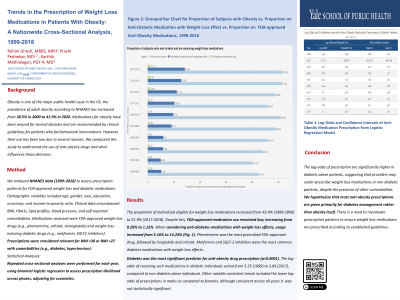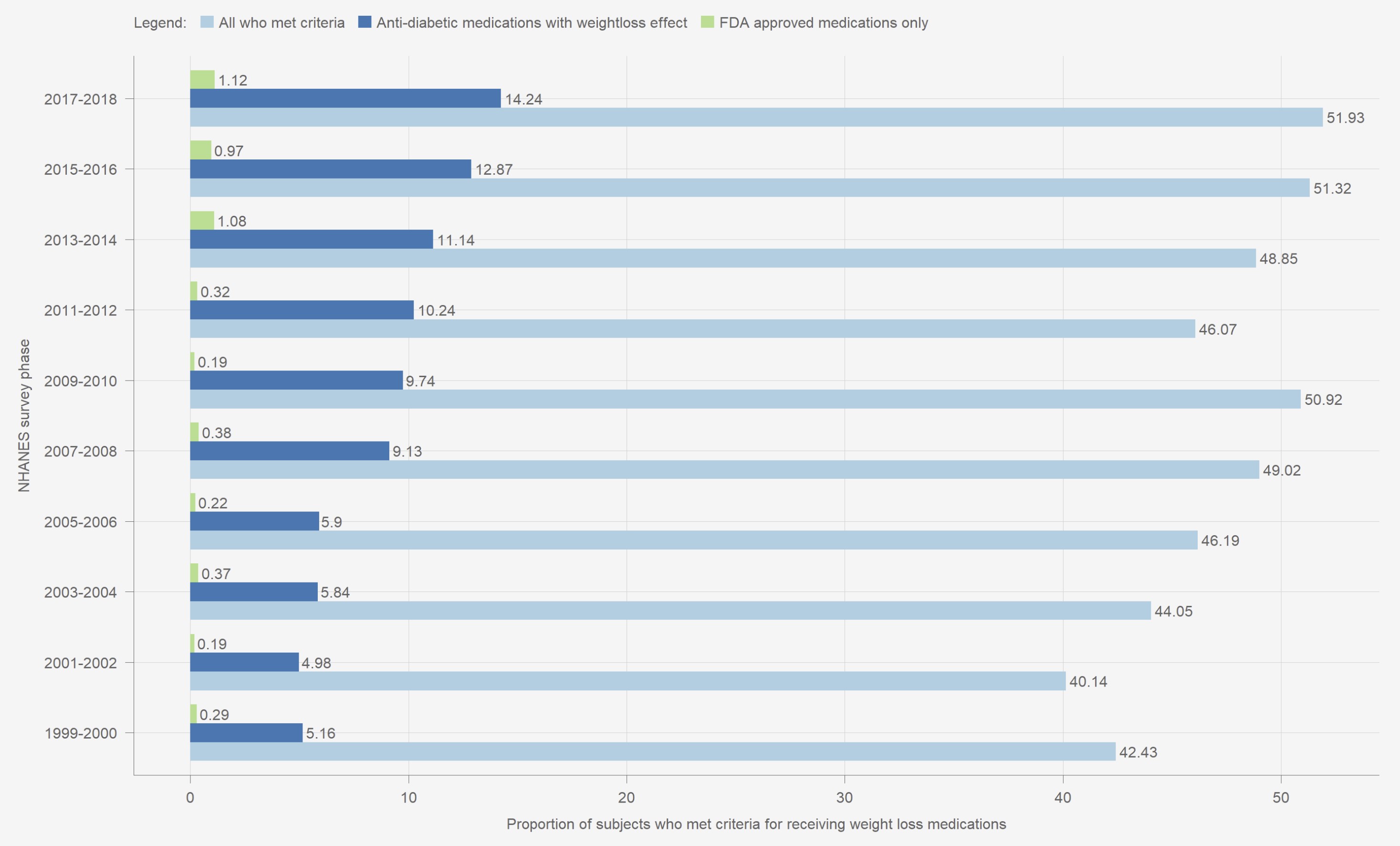Sunday Poster Session
Category: Obesity
P1448 - Trends in the Prescription of Weight Loss Medications in Patients With Obesity: A Nationwide Cross-Sectional Analysis, 1999-2018
Sunday, October 27, 2024
3:30 PM - 7:00 PM ET
Location: Exhibit Hall E

Has Audio

Rohini Ghosh, MPH
Yale University School of Medicine
New Haven, CT
Presenting Author(s)
Rohini Ghosh, MPH1, Karthik Mathialagan, MD2, Prachi Pednekar, MD3
1Yale University School of Medicine, New Haven, CT; 2Yale New Haven Health, Bridgeport Hospital, Bridgeport, CT; 3Yale New Haven Hospital, New Haven, CT
Introduction: The prevalence of adult obesity in the US has increased from 30.5% in 2000 to 41.9% in 2020. Anti-obesity medications have been around for several decades, but their use is still low
Methods: We used NHANES data from 1999 to 2018. The demographic data included age, gender, self-reported race, education level, insurance, income-poverty ratio. Lab and physical exam data included BMI, Hemoglobin A1C, lipid profile, blood pressure, self-reported comorbidities. Prescription medication data included FDA-approved weight-loss drugs such as phentermine, sibutramine, diethylpropion, phentermine/topiramate, orlistat, bupropion/naltrexone, GLP-1 agonist. Weight-loss inducing anti-diabetic drugs included pramlintide, SGLT-2 inhibitors, metformin. Subjects with a BMI >30 or >27 with at least one comorbidity (diabetes, hypertension, hyperlipidemia, or cardiovascular disease) were considered to meet the criteria for prescription. A binomial logistic regression model was used to determine the log-odds of prescription of weight-loss drugs in each phase, given a fixed set of covariates. As the data included a different study population for each phase, each was analyzed separately
Results: The proportion of subjects who met the criteria for receiving weight-loss drugs increased from 42.4% in 1999-2000 to 51.9% in 2017-2018. However, the use of FDA-approved drugs alone remained low ranging from 0.29% in 1999-2000 to 1.12% in 2017-2018. When anti-diabetes drugs with weight-loss effects were included, the proportion of use ranged from 5.16% in 1999-2000 to 14.24% in 2017-2018. The most prescribed FDA-approved medication was phentermine followed by liraglutide and orlistat. The most prescribed anti-diabetic medication was metformin followed by SGLT-2 inhibitors. Amongst all predictors of the model, diabetes was most consistently significant (p-value < 0.0001 across all phases). The log-odds of prescription given diabetes ranged from 5.25 (1999-2000, 95% CI 3.54-6.98) to 3.69 (2017-2018, 95% CI 3.17-4.23) as compared to no diabetes. Other notable trends included the lower log-odds of prescriptions in males as compared to females, consistent across all years, but it was not statistically significant
Discussion: This study shows the use of weight loss medications still remains low. The log-odds of prescription are disproportionately higher only in diabetic obese patients, suggesting that providers may be under-prescribing these medications even when other comorbidities warrant their use, except in diabetic patients

Disclosures:
Rohini Ghosh, MPH1, Karthik Mathialagan, MD2, Prachi Pednekar, MD3. P1448 - Trends in the Prescription of Weight Loss Medications in Patients With Obesity: A Nationwide Cross-Sectional Analysis, 1999-2018, ACG 2024 Annual Scientific Meeting Abstracts. Philadelphia, PA: American College of Gastroenterology.
1Yale University School of Medicine, New Haven, CT; 2Yale New Haven Health, Bridgeport Hospital, Bridgeport, CT; 3Yale New Haven Hospital, New Haven, CT
Introduction: The prevalence of adult obesity in the US has increased from 30.5% in 2000 to 41.9% in 2020. Anti-obesity medications have been around for several decades, but their use is still low
Methods: We used NHANES data from 1999 to 2018. The demographic data included age, gender, self-reported race, education level, insurance, income-poverty ratio. Lab and physical exam data included BMI, Hemoglobin A1C, lipid profile, blood pressure, self-reported comorbidities. Prescription medication data included FDA-approved weight-loss drugs such as phentermine, sibutramine, diethylpropion, phentermine/topiramate, orlistat, bupropion/naltrexone, GLP-1 agonist. Weight-loss inducing anti-diabetic drugs included pramlintide, SGLT-2 inhibitors, metformin. Subjects with a BMI >30 or >27 with at least one comorbidity (diabetes, hypertension, hyperlipidemia, or cardiovascular disease) were considered to meet the criteria for prescription. A binomial logistic regression model was used to determine the log-odds of prescription of weight-loss drugs in each phase, given a fixed set of covariates. As the data included a different study population for each phase, each was analyzed separately
Results: The proportion of subjects who met the criteria for receiving weight-loss drugs increased from 42.4% in 1999-2000 to 51.9% in 2017-2018. However, the use of FDA-approved drugs alone remained low ranging from 0.29% in 1999-2000 to 1.12% in 2017-2018. When anti-diabetes drugs with weight-loss effects were included, the proportion of use ranged from 5.16% in 1999-2000 to 14.24% in 2017-2018. The most prescribed FDA-approved medication was phentermine followed by liraglutide and orlistat. The most prescribed anti-diabetic medication was metformin followed by SGLT-2 inhibitors. Amongst all predictors of the model, diabetes was most consistently significant (p-value < 0.0001 across all phases). The log-odds of prescription given diabetes ranged from 5.25 (1999-2000, 95% CI 3.54-6.98) to 3.69 (2017-2018, 95% CI 3.17-4.23) as compared to no diabetes. Other notable trends included the lower log-odds of prescriptions in males as compared to females, consistent across all years, but it was not statistically significant
Discussion: This study shows the use of weight loss medications still remains low. The log-odds of prescription are disproportionately higher only in diabetic obese patients, suggesting that providers may be under-prescribing these medications even when other comorbidities warrant their use, except in diabetic patients

Figure: The proportion of subjects who met the criteria and received weight loss medications.
Disclosures:
Rohini Ghosh indicated no relevant financial relationships.
Karthik Mathialagan indicated no relevant financial relationships.
Prachi Pednekar indicated no relevant financial relationships.
Rohini Ghosh, MPH1, Karthik Mathialagan, MD2, Prachi Pednekar, MD3. P1448 - Trends in the Prescription of Weight Loss Medications in Patients With Obesity: A Nationwide Cross-Sectional Analysis, 1999-2018, ACG 2024 Annual Scientific Meeting Abstracts. Philadelphia, PA: American College of Gastroenterology.

